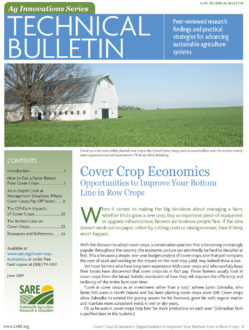
Ken Rulon, Arcadia, Ind.
Primary cover crops: cereal rye, annual ryegrass, oats, radish, clover, rapeseed and hairy vetch
To say that data drives decisions for Ken Rulon is an understatement. Utilizing one-acre grid sampling for twenty-four years, Rulon and his family have learned there is a linear relationship between soil organic matter and yield. “The data is clear. We need something growing on the soil at all times,” Rulon says. He farms approximately 6,000 acres with his family in north-central Indiana. This fourth-generation family farm has used no-till management since 1989 and started using cover crops around 2006. Their general philosophy is that conservation is the best economic model and that oxidizing soil carbon through tillage is not sustainable long term.
Once they combined cover crops with no-till, Rulon’s soil organic matter levels increased more than 1% over the next decade on some fields. With cover crops, he documented increased soil moisture during the growing season, decreased soil surface temperatures, increased soil aggregate stability, increased soil organic matter levels and improved yields.
One of Rulon’s primary goals with cover crops has been to increase soil organic matter levels and reduce input costs. He notes that research at Purdue University found cover crops reduced nitrogen leaching by 50%. Through his own experience, years of cover cropping has allowed Rulon to cut fertilizer use and still maintain adequate soil fertility levels. He reduced phosphorus inputs by 20 pounds per acre, potassium by 30 pounds per acre and nitrogen by 35 pounds per acre. In-field trials conducted for multiple years with multiple rates of nitrogen fertilizer demonstrate that 165 pounds of nitrogen per acre achieves maximum economic yields for his operation. This compares to the more typical rate for his region of 200 pounds of nitrogen per acre for corn.
The cost savings that come from reducing his fertilizer inputs has not resulted in lower yields. In fact, Rulon’s operation consistently achieves yields higher than the county average. Multiple years of yield data confirm a yield benefit of approximately seven bushels per acre for corn and almost two bushels per acres for soybeans.
Profitability aside, Rulon believes managing a sustainable operation implies they must meet their present needs without sacrificing the future. That is why he appreciates the role cover crops and no-till play in protecting the soil, sequestering carbon and improving the overall resilience of the farm. “We encourage everyone to develop data for their operation to find the system that works best on your soils and in your region,” Rulon says.
